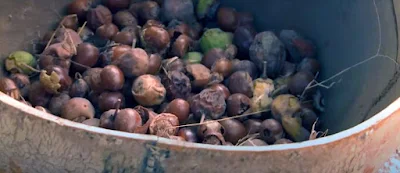Shea Butter is a Staple of African Life
Shea butter is a staple of African skin care, cooking and medicine for a millennia.
Shea butter comes from an African nut shea tree and is used in cosmetics, cooking and medicine. For centuries the shea tree and the butter produced from its fruit have been central to the lives of rural communities mainly women in Mali and other west African countries. Mali has one of the largest areas of trees in the so-called shea belt.
 |
| Shea nuts used to produce shea nut butter |
Shea butter comes from the nuts of karité trees that grow in the Sahel region extending from West to East Africa, from Guinea and Senegal to Uganda and South Sudan.
The women continue to harvest the fruit by hand from wild trees which grow in abundance across Mali’s red earth. The nuts are extracted, boiled, dried and shelled by groups of women and girls working together. They are then crushed, roasted and ground into a paste to make the butter. This physically demanding process has changed little since the late 18th century.
For centuries shea butter has been referred to as women’s gold because of its rich golden color and because it provides employment, medicinal benefits and nutrition for millions of women across Africa. The sector employs an estimated 3 million women across West Africa, generates between USD 90 million and USD 200 million a year from exports and promotes economic activity in communities
Nut collectors are usually women and children engaged solely in the collection of shea nuts. They collect nuts from fields or buy them from farmers and resell them to women’s groups or to secondary nut sellers. The shea nuts butter has traditionally been used for cooking and as a cosmetic product particularly in skin creams and soaps.
Nut collectors and transformers collect nuts and also participate in the transformation of the nuts into butter. Women often keep some of the butter for their households to eat. These groups sell their butter and derivative products at local markets, or to national or international traders. Individuals who profit most from the shea industry are the managers of the organizations, who earn three times more than the average woman worker.
Shea butter is also used in food products such as chocolates. Confect-ioners use it as a cocoa butter equivalent to give chocolates a higher melting point and a smoother texture. The butter is used in popular chocolate bars.
The Burkina Faso shea sector contributes to 23.8 percent of women received an income solely from shea; 6.5 percent supplemented their income from agriculture, 30.3 percent from small-scale business and 30.8 percent from handmade or nonindustrial work.
Shea is an important non-timber forest product in Burkina Faso because of its medicinal properties, nutritional uses and income-generating potential. It contributes to export earnings it is the third most exported product creates income for women, especially in rural areas, and shea butter groups enable women to acquire new skills, receive support from other women and promote women’s agency and collective action.
Shea activities provide incomes for women mainly but few for men: they range from the collection of nuts, to making raw shea butter for consumption and treating shea butter for creams, pomades and cosmetics. Shea butter is Burkina Faso’s third most important export product after cotton and livestock products, and for this reason it has an important socio-cultural role and is also a critical element in the national economy.
Together we build awareness that boost harmony, education, and success, below are more links to articles you will find thought provoking.
- Deadliest routes for refugees
- Cooking with shea butter oil
- Worst serial killers recorded in history are women
- Indigenous healers and plants used
- Night running illness or magic
- What is back to Africa

 Since 2007
Since 2007


